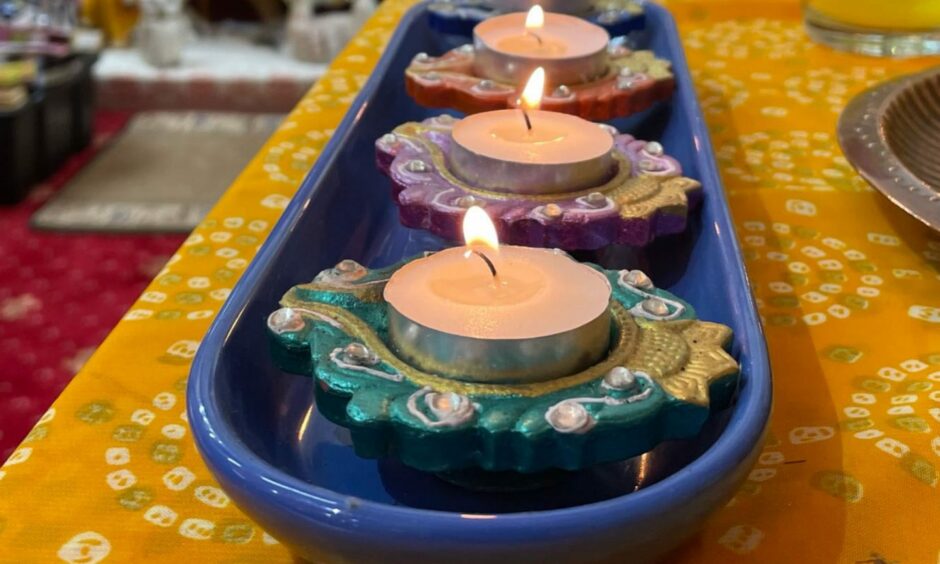Known as the Festival of Lights and marking the start of the Hindu new year, Diwali is a five-day celebration where believers come together to worship, celebrate and enjoy a meal together.
This main meal is cooked in the temple and the whole community is involved, working together to feed the masses.
Determined by the position of the moon, the festival is currently taking place, and runs until October 26, with the main celebration last night (Monday October 24).
Around 150 individuals from across Dundee and the wider Tayside area came together at the Hindu Cultural and Community Centre on Taylor’s Lane to worship ceremonies of Lakshmi, the goddess of prosperity and wealth.
Candles were lit in remembrance of deity Rama and his wife Sita who returned to their kingdom after Rama defeated the evil spirit Ravana. The story narrates that oil lamps were lit by passers by to guide them on their way home.
And as with any major event, the food is an important part of the celebration. Firstly, where people share gifts of mithai (sweets) throughout the five days, and secondly at the Prasad (food offering) which is part of the worship and the bhojan (meal) served at the end on the main celebration day.
It is also tradition to wear the finest clothing and illuminate the interior and exterior of homes with diwas (oil lamps) and colourful rangoli designs in the shapes of flowers, leaves and animals which are made using ground rice.
What happens on the main Diwali festival day?
Open to anyone, last night’s celebration started at 7pm with a Lakshmi Puja (worship of goddess Lakshmi), where attendees sat and listened to the prayer taking place.
From 7.45pm the bhajans (devotional songs) were performed by women, with instruments including a piano accordion and dhol drums being played.
The Aarti then took place at 9pm with everyone standing and singing the Om Jai Jagdish Hare worship song, and lighting a flame which was offered to the goddess Lakshmi to bless.
Devotees then passed their hands over the flame and brushed them over their heads to take the blessing.
This was followed by the prasad (offering) to the goddess containing the main sweet dish of halwa, which is a thick paste made from flour, semolina, or finely ground seeds or nuts, and sweetened with sugar or honey, as well as fruits, chocolates, and other Indian sweet dishes barfi and ladoos.
The celebration was rounded off with the Bhojan (meal).
Vegetarian food and sweet treats
Due to their belief of animals being sacred, no meat is cooked or served within the Hindu temple. An entirely vegetarian meal was plated, made up of different dishes cooked within the temple by the temple committee.
The different dishes included chickpea curry, cauliflower and pea curry, plus rice pudding and halwa prasad. White rice and chola pooris were served and used to eat the curries.
The sweet dish mohanthal – a fudge-like creation using gram flour, ghee, sugar and almonds – was given out in pieces for those in attendance to help themselves.
Contrary to many Indian recipes, no onions or garlic were using during the preparation of the dishes within the temple, due to the belief that they invoke carnal energy in the body, as well as to avoid certain smells.
Instead, whole spices such as black mustard seeds, bay leaves, cardamom, cloves and cinnamon were heated in a hot oil and used to create the base flavour of the main dishes.
All the food for the celebration was made on the day and cooked fresh during the celebration by the men who attend the event, as well as some women who helped roll out the chola pooris, a deep-fried bread made from maida white flour.
Committee members arrived at the temple for 5pm to start with preparations and continued cooking throughout the event until food was served at 9.45pm.
Similarly to the prayer and worship, those making the food were able to spend time with one another, and others in their community while creating a meal together.
Attendees then queued to receive the array of food that had been made for the event.
Elders and children were served first, followed by the women and men.
Thali plates, resembling trays with multiple sections, were used to allow each part of the meal to be placed into separate compartments. This means no two dishes touch one another.
Attendees sat on the benches or on the floor and enjoyed the food while conversing with friends and family.
As with any festival, the food at the event brought everyone together at the end, once more further cementing that feeling of celebration and enjoyment.





















Conversation